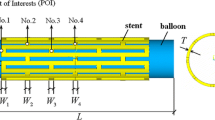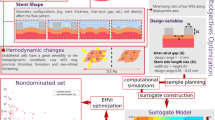Abstract
Purpose
Recent studies suggested that suboptimal delivery and longitudinal stent deformation can result in in-stent restenosis. Therefore, the purpose of this paper was to study the effect of stent geometry on stent flexibility and longitudinal stiffness (LS) and optimize the two metrics simultaneously. Then, the reliable and accurate relationships between metrics and design variables were established.
Methods
A multi-objective optimization method based on finite element analysis was proposed for the investigation and improvement of stent flexibility and LS. The relative influences of design variables on the two metrics were evaluated on the basis of the main effects. Three surrogate models, namely, the response surface model (RSM), radial basis function neural network (RBF), and Kriging were employed and compared.
Results
The accuracies of the three models in fitting flexibility were nearly similar, although Kriging made more accurate prediction in LS. The link width played important roles in flexibility and LS. Although the flexibility of the optimal stent decreased by 13%, the LS increased by 48.3%.
Conclusions
The obtained results showed that the multi-objective optimization method is efficient in predicting an optimal stent design. The method presented in this paper can be useful in optimizing stent design and improving the comprehensive mechanical properties of stents.















Similar content being viewed by others
References
Azaouzi, M., N. Lebaal, A. Makradi, and S. Belouettar. Optimization based simulation of self-expanding nitinol stent. Mater. Des. 50(17):917–928, 2013.
Bressloff, N. W., G. Ragkousis, and N. Curzen. Design optimisation of coronary artery stent systems. Ann. Biomed. Eng. 44(2):357–367, 2016.
Deb, K., A. Pratap, S. Agarwal, and T. Meyarivan. A fast and elitist multi-objective genetic algorithm: NSGA-II. IEEE T Evol. Comput. 6(2):182–197, 2002.
Demanget, N., P. Latil, L. Orgeas, P. Badel, S. Avril, C. Geindreau, J. N. Albertini, and J. P. Favre. Severe bending of two aortic stent-grafts: an experimental and numerical mechanical analysis. Ann. Biomed. Eng. 40(12):2674–2686, 2012.
Eshghi, N., M. H. Hojjati, M. Imani, and A. M. Goudarzi. Finite element analysis of mechanical behaviors of coronary stent. Procedia Eng. 10(2):3056–3061, 2011.
Foin, N., C. D. Mario, D. P. Francis, and J. E. Davies. Stent flexibility versus concertina effect: mechanism of an unpleasant trade-off in stent design and its implications for stent selection in the cath-lab. Int. J. Cardiol. 164(3):259–261, 2013.
Gundert, T. J., A. L. Marsden, W. Yang, and J. F. LaDisa. Optimization of cardiovascular stent design using computational fluid dynamics. J. Biomech. Eng. 134(1):031002, 2012.
Hanratty, C. G., and S. J. Walsh. Longitudinal compression: a new complication with modern coronary stent platforms-time to think beyond deliverability? Eurointervention. 7(7):872–877, 2011.
Hsiao, H. M., C. T. Yeh, C. Wang, L. Chao, and D. Li. Effects of stent design on new clinical issue of longitudinal stent compression in interventional cardiology. Biomed. Microdevices. 16(4):599–607, 2014.
Imani, M. Simulation of mechanical behaviors of NIR stent in a stenotic artery using finite element method. World Appl. Sci. J. 22(7):892–897, 2013.
Imani, S. M., A. M. Goudarzi, S. E. Ghasemi, A. Kalani, and J. Mahdinejad. Analysis of the stent expansion in a stenosed artery using finite element method: Application to stent versus stent study. Proc. Inst. Mech. Eng. Part H: J Eng. Med. 228(10):996–1004, 2014.
Imani, M., A. M. Goudarzi, and M. H. Hojjati. Finite element analysis of mechanical behaviors of multi-link stent in a coronary artery with plaque. World Appl. Sci. J. 3(21):1597–1602, 2013.
Imani, S. M., A. M. Goudarzi, P. Valipour, M. Barzegar, J. Mahdinejad, and S. E. Ghasemi. Application of finite element method to comparing the NIR stent with the multi-link stent for narrowings in coronary arteries. Acta Mech. Solida Sin. 28(5):605–612, 2015.
Jones, D., M. Schonlau, and W. Welch. Efficient global optimization of expensive black-box functions. J. Glob. Optim. 13(4):455–492, 1998.
Ju, F., Z. Xia, and C. Zhou. Repeated unit cell (RUC) approach for pure bending analysis of coronary stents. Comput. Method Biomech. Biomed. Eng. 11(4):419–431, 2008.
Kwok, O. H. Stent concertina: stent design does matter. J. Invasive Cardiol. 25(6):114–119, 2013.
Maleckis, K., P. Deegan, W. Poulson, C. Sievers, A. Desyatova, J. MacTaggart, and A. Kamenskiy. Comparison of femoroapopliteal artery stents under axial and radial compression, axial tension, bending, and torsion deformations. J. Mech. Behav. Biomed. 75:160–168, 2017.
Matheron, G. Principles of geostatistics. Econ. Geol. 58(8):1246–1266, 1963.
Morris, M. D., and T. J. Mitchell. Exploratory designs for computational experiments. J. Stat. Plan Inference 43(3):381–402, 1995.
Murphy, E. A., and F. J. Boyle. Reducing in-stent restenosis through novel stent flow field augmentation. Cardiovasc. Eng. Technol. 3(4):353–373, 2012.
Myers, R. H., and D. C. Montgomery. Response surface methodology: process and product optimization using designed experiment. J. Stat. Plan Inference 59:185–186, 1995.
Ni, Z., X. Gu, and Y. Wang. Rapid prediction method for nonlinear expansion process of medical vascular stent. Sci China Ser E: Technol Sci. 52(5):1323–1330, 2009.
Ni, X., C. Pan, and P. B. Gangadhara. Numerical investigations of the mechanical properties of a braided non-vascular stent design using finite element method. Comput. Methods Biomech. Biomed. Eng. 18(10):1117–1125, 2015.
Ni, X., G. Wang, Z. Long, and C. Pan. Analysis of mechanical performance of braided esophageal stent structure and its wires. J. Southeast Univ. (English Ed) 28(4):457–463, 2012.
Ni, X., Y. Zhang, H. Zhao, and C. Pan. Numerical research on the biomechanical behaviour of braided stents with different end shapes and stent-oesophagus interaction. Int. J. Numer. Method Biomed. Eng. 34(6):e2971, 2018.
Ormiston, J. A., B. Webber, and M. W. Webster. Stent longitudinal integrity: bench insights into a clinical problem. Jacc-Cardiovasc Int. 4(12):1310–1317, 2011.
Pant, S., N. W. Bressloff, and G. Limbert. Geometry parameterization and multidisciplinary constrained optimisation of coronary stents. Biomech. Model. Mechanobiol. 11(1–2):61–82, 2012.
Pant, S., G. Limbert, N. Curzen, and N. W. Bressloff. Multi-objective design optimization of coronary stents. Biomaterials. 32(31):7755–7773, 2011.
Park, J. K., K. S. Lim, I. H. Bae, J. P. Nam, J. H. Cho, C. Choi, J. W. Nah, and M. H. Jeong. Stent linker effect in a porcine coronary restenosis model. J. Mech. Behav. Biomed. 53:68–77, 2016.
Petrini, L., F. Migliavacca, F. Auricchio, and G. Dubini. Numerical investigation of the intravascular coronary stent flexibility. J. Biomech. 37(4):495–501, 2004.
Ragkousis, G. E., N. Curzen, and N. W. Bressloff. Multi-objective optimisation of stent dilation strategy in a patient-specific coronary artery via computational and surrogate modeling. J. Biomech. 49(2):205–215, 2016.
Rigattieri, S., A. Sciahbasi, and P. Loschiavo. The clinical spectrum of longitudinal deformation of coronary stents: from a mere angiographic finding to a severe complication. J. Invasive Cardiol. 25(5):101–105, 2013.
Shen, X., Y. Deng, Z. Xie, S. Ji, and H. Zhu. Flexibility behavior of coronary artery stents: the role of linker investigated with numerical simulation. J. Mech. Med. Biol. 17(08):1750112, 2017.
Shen, X., Z. Xie, Y. Deng, and S. Ji. Effects of metal material stent design parameters on longitudinal stent strength. Key Eng. Mater. 723:299–304, 2017.
Shen, X., H. Yi, and Z. Ni. Multi-objective design optimization of coronary stent mechanical properties. Chin. J. Dial Artif. Organs. 4(3):835–838, 2012.
Simpson, T. W., D. K. J. Lin, and W. Chen. Sampling strategies for computer experiments: design and analysis. Int. J. Reliab. Appl. 2(3):209–240, 2001.
Williams, P. D., M. A. Mamas, K. P. Morgan, M. EI-Omar, B. Clarke, A. Bainbridge, F. Fath-Ordoubadi, and D. G. Fraser. Longitudinal stent deformation: a retrospective analysis of frequency and mechanisms. Eurointervention 8(2):267–274, 2012.
Wu, W., D. Yang, M. Qi, and W. Wang. An FEA method to study flexibility of expanded coronary stents. J. Mater. Process Technol. 184:447–450, 2007.
Zhao, S., L. Gu, and S. R. Foremming. Effects of arterial strain and stress in the prediction of restenosis risk: computer modeling of stent trials. Biomed. Eng. Lett. 2(3):158–163, 2012.
Acknowledgment
This project is supported by the National Natural Science Foundation of China (51305171), Natural Science Foundation of Jiangsu Province (BK20130525), Natural Science Foundation of the Higher Education Institutions of Jiangsu Province (13KJB460006), China Postdoctoral Science Foundation (2011M500858), Foundation of Jiangsu University (10JDG123) and Project of Jiangsu University for training young backbone teachers.
Conflict of interest
Xiang Shen, Hongfei Zhu, Jiabao Jiang, Yongquan Deng and Song Ji declare that they have no conflict of interest.
Ethical Standards
This article does not contain any studies with human participants or animals performed by any of the authors.
Author information
Authors and Affiliations
Corresponding author
Additional information
Associate Editor Dr. Ajit P. Yoganathan and Dr. James E. Moore oversaw the review of this article.
Publisher's Note
Springer Nature remains neutral with regard to jurisdictional claims in published maps and institutional affiliations.
Rights and permissions
About this article
Cite this article
Shen, X., Zhu, H., Jiang, J. et al. Multi-Objective Optimization Design of Balloon-Expandable Coronary Stent. Cardiovasc Eng Tech 10, 10–21 (2019). https://doi.org/10.1007/s13239-019-00401-w
Received:
Accepted:
Published:
Issue Date:
DOI: https://doi.org/10.1007/s13239-019-00401-w




